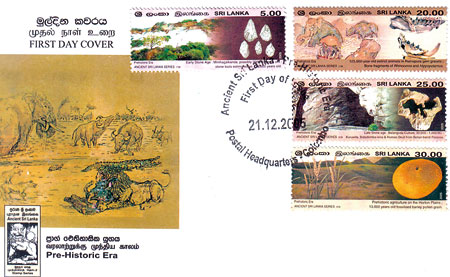Though a small island,
Sri Lanka boasts of a
heritage going back to
millions of years. In what archaeologists call the Prag History Age – commonly referred to as the Pre Historic era – it has been revealed that beyond the
historically recorded period, people had lived through an unrecorded period of 125,000 years. There is evidence to prove that during that period people had the technical skills to make structures using stones and fragments of bones.
A set of four stamps depicting archaeological findings belonging to the Pre-Historic era was issued on December 21, 2005 introducing
a Stamp Series titled Ancient
Sri Lanka.
Archaeologists have divided this primitive period into three called Paleouthic Age (Pura Shilā Yugaya in Sinhala), Mesolithic Age (Madya Shilā Yugaya) and Neolithic Age (Nava Shilā Yugaya).
The first – the Paleouthic Age has been further divided into three. The first is known as Lower Paleouthic Age.
Stone tools have been
discovered which are said to have been used over 250,000 years ago. Renowned
archaeologist Professor Shiran Deraniyagala says that these have been discovered from earth deposits beneath the earth layers marked 125,000 years.
These were possibly used by the ‘homo habilis’ type of man. Minihagalakanda in Panama in the southern coastal area, depicted in the Rs. 5 stamp, is
considered to be one of the earliest habitats in Sri Lanka dating back to over 300,000 years. Stone tools which were possibly used 125,000 years ago are seen on the right.
Tools that belong to the age referred to as the Middle Paleouthic Age have been found from earth deposits in Ratnapura, coastal region around Hambantota and in Iranamadu in the north. Physically developed man known as ‘homo erectus’ is supposed to have used these tools which indicate the nature of his activities and his physical build up. The Rs. 20 stamp depicts 125,000 year old extinct animals in Ratnapura gem gravels. Also seen
are bone fragments of the
rhinoceros and the hippopotamus.
No tools or equipment have been discovered belonging to the Upper Paleouthic Age.
In the Mesolithic Age, small size tools have been used by the ‘homo sepeance sepunane’ – the prag
modern man – around 40,000 years ago. He lived in all parts of the country. The best known areas from where a lot of evidence have been found are the caves of Batadomba (Kuruvita), Belilana (Kitulgala), Pahiyangala, Maniyamgama (Asamadagala – Avissawella) in the wet zone, caves in Sigiriya, Aligala and Potaana in the dry zone, and fossils deposits in coastal zones like Pallemalala.
The Mesolithic Age – also referred to as the Late Stone Age – covers the Balangoda Culture ranging from 30,000 – 1,000 B.C. The Batadomba cave and a human skull of the Balangoda man are seen in the Rs. 25 stamp.
Although not much information is available about the Neolithic Age, available evidence
indicates that people were
familiar with agriculture over 13,000 years ago. Barley has been a prominent crop in the Horton Plains.
Pre-Historic agriculture is depicted in the Rs. 30 stamp which also shows a 13,000 year old fossilised barley pollen grain enlarged to about three thousand times. |


